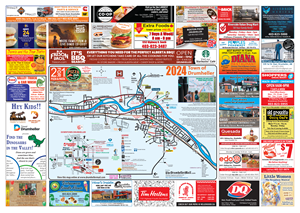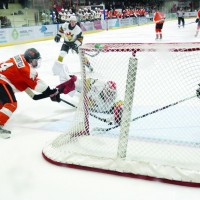Catch up with The Drumheller Mail/inSide Drumheller reporter Michael James as he trains for the Dinosaur Valley Half Marathon and shares his insight in biweekly feature On the Run.
 April 12, 2013
April 12, 2013
I have been looking at myself in the mirror lately and I haven’t been liking what I see. There is some excess baggage building up.
With that in mind, I decided to shed some of my bad habits, get in shape, and have vowed to run in this year’s Dinosaur Valley Half Marathon.
To get an idea of the magnitude of this decision, I should explain where I am coming from.
At the time of writing this, I am almost 29 years old, 5’9”, and roughly 195 pounds. I have an immense sweet tooth and will generally give into temptation when it comes to junk food.
The worst habit I’ve picked up is an addiction to Coca-Cola. Since beginning my undergraduate degree, just under 11 years ago, I’ve been drinking roughly two to three cans of pop per day, sometimes more.
That, coupled with a generally sedentary lifestyle of office work and an aversion to exercise during my free time, has led to a sharp decrease in my overall physical fitness in the latter half of my twenties.
It’s time to change all of that.
Over the spring and summer I will get active and train to run the Dinosaur Valley Half Marathon.
For the next five months, I will give regular updates on my progress here, in inSide Drumheller, and talk on different aspects of getting in shape for the race.
Join me as we go on the run!
April 26, 2013
In my last column I vowed to run this year’s Dinosaur Half Marathon and get into shape. The question is, how to start getting in shape to run?
I’ve never run as a regular activity and certainly not with a goal in mind. Do I just run as far and as often as I can?
Morgan Syvertsen, a running, swimming, biking machine, gave me some advice on how to start.
“The first thing to do is establish an aerobic base. To do that, you go out and run really, really slow, going as far as you can go for about half an hour. Then, you keep building it up from there. The baseline is being able to run and still carry on a conversation. Keep stepping up the distances each time. Once you’ve got that aerobic base, the rest is just teaching your body to get used to the abuse,” said Syvertsen.
I started off running around the track at the Badlands Community facility doing just that; slowly moving along, listening to some music for inspiration (I can occasionally be seen lip-synching or playing air guitar to whatever song I’m listening to as I run).
I’ve also been alternating how I run. I feel like my cardio is coming along, but my muscles are holding me back. During the week, I’ll run shorter distances, but at a fast pace, to train my muscles. On the weekend, I’ll do a long run at a slower pace.
Syvertsen had another piece of advice for those new to running.
“Also, it helps to adopt the run/walk approach so you don’t burn out as fast. For example, you run 10 minutes and then walk 5 minutes. Over time, you increase the amount of time you run and decrease the time you walk until you’re running the full time,” said Syvertsen.
I’ve also managed to kick my Coca Cola addiction. I had gone cold-turkey February 19, and since then have only had a few. I’ve lost around 10 pounds since then.
Hopefully, the weather keeps getting better so I can hit Drumheller’s trail system.
I’ll see you out there on the run!
May 10, 2013
To get ready for the Half Marathon, I’ve been out running as much as I can over the past two weeks.
Equally important to determining how to train is where to train. The right route can make the difference in having a good run.
The Badlands Community Facility is a good place to run, especially when the weather outside is uncooperative. When there, I stick to the running track, though those who want to watch a little TV get a lot of mileage out of the tread mills.
But, since the weather has warmed up, I’ve been taking advantage of Drumheller’s extensive trail network. I find it a bit more engaging for two reasons. The first is the scenery constantly changes and the second, and perhaps most important, reason is if you feel like quitting halfway through, you still have to get home, so might as well keep pushing yourself.
During the week, I’ll do a short, high paced run along the river trail between the Badlands Community Facility and 19 street SE. There and back is about 5 kilometres, which lets me push myself to help build up my leg muscles and cardio.
This past weekend was my first crack at doing a long run. On Sunday I ran/walked from the Badlands Community Facility to where the hiking trail crosses Highway 838, near the Royal Tyrrell Museum, and back. In total, that route is about 12 kilometres.
I used the run/walk approach and managed to run most of the way at a slow, plodding pace. By the end, I was pretty worn out.
I find the aforementioned routes to be the easiest for me, but for anyone wanting to develop their own routes, I find Google Maps can help plan a route, especially if you’re looking to achieve set distances.
I’ll have the first test of my training in under a month. I signed up with a team to do the DinoFest Triathlon on June 8, where I’ll be doing a 5 kilometre run.
May 24, 2013
What to wear, what to wear.
I’ve learned over the past few weeks just how important the right pair of shoes can be. I’ve used the same pair of tattered running shoes for awhile and, considering their ragged state, decided it was time for a new pair.
Gavin Makse, athletic director at St. Anthony’s School and marathon runner, had some advice.
“When you’re buying shoes, have a few different pairs in mind to try. Make sure they’re comfortable and run around the store to see how they feel,” said Makse. “Shoes are marketed to look cool, but you have to think about if they’ll work for your feet.”
One thing I wanted to try was thin-soled shoes. I found a pair I liked and jogged around the store, to the bewilderment of other customers. It felt different, but I knew getting my feet used to them was part of the process.
“If you go with running shoes that are more a barefoot feel, you almost have to train just to wear them,” said Makse.
After getting them home, the next thing I had to think about was how to run. Running the wrong way can lead to soreness and even injury.
Initially, I would say I was a heel-striker, someone who, when running, lands on their heel and kicks off with their toes. The vast majority of people land on their heels.
“Most people tend to land on their heels. It’s supposed to be less than an ideal way to land, but if you’re not having any injuries, you might not have to change. If you do change, go for a toe strike,” said Makse.
To change my style to a toe-strike, it took a couple running sessions concentrating on my form. The change has improved my runs, I feel like I run longer and with less muscle soreness than heel-striking.
My first run with thin-soled shoes was a different experience. I could feel a lot more under my feet and each step felt like more of an impact, but, by the end, my feet were killing me.
I kept at if for subsequent runs and tried to train my feet, but it didn’t seem like they were getting any better. After a few runs, I gave up and switched back to my old, ratty shoes.
“There has been some research saying it’s supposed to have less risk of injury, but you have to think about what terrain you’re running on. Your feet flex, blend, and react differently. Trying it on grass may help improve your ankle and calf strength,” said Makse.
I’ll give thin-soled runners another shot, but my shoe experiment is looking like a case of “if it isn’t broken, don’t fix it.”












































